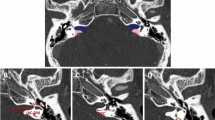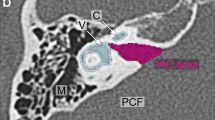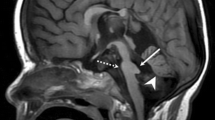Abstract
The cochlear aqueduct is a bony channel which contains the fibrous periotic duct and connects the perilymphatic space of the basal turn of the cochlea with the subarachnoid space of the posterior cranial cavity. Previous histological studies suggested that patency depended on age, whereas a more recent study showed no statistical correlation between age and patency. To clarify patency in pediatric cochlear aqueducts, we selected 21 temporal bones from 12 infants and children, varying in age from birth to 9 years, in which the cochlear aqueduct was fully visible on one histological section. Photographs were taken for documentation and the length and width of the orifice of the external aperture of the aqueduct at the scala tympani were measured and followed to the internal aperture at the subarachnoid space. The lumen of the duct was examined for mononucleated cells, blood cells and fibrous tissue. Measurements revealed that the mean length of the cochlear aqueduct was 4.6 mm (range, 2.4–10.7 mm), mean width of the external aperture was 484 μm (range, 225–869 μm), and mean width of the internal aperture was 1293 μm (range, 699–2344 μm). The mean diameter of the narrowest part (isthmus) was 151 μm (range, 75–244 μm). In all temporal bones the cochlear aqueduct was patent, with one exception. This latter temporal bone was from a 2-month-old girl with multiple intralabyrinthine anomalies, with the missing cochlear aqueduct believed to be due to an aplasia. Our results support prior measurements of the cochlear aqueduct and demonstrate a short and patent cochlear aqueduct in newborns. With growth, a significant increasing length of the duct was found.
Similar content being viewed by others
References
Allen GW (1987) Fluid flow in the cochlear aqueduct and cochlea-hydrodynamic considerations in perilymph fistula, stapes gusher, and secondary endolymphatic hydrops. Am J Otol 8: 319–322
Anson BJ, Donaldson JA, Warpeha RL, Winch TR (1965) The vestibular and cochlear aqueducts: their variational anatomy in the adult human ear. Laryngoscope 75: 1203–1223
Arenberg IK (1984) Radiographic classification of the vestibular and cochlear aqueducts: the paired correlation between normal and abnormal vestibular aqueduct and cochlear aqueduct anatomy. Laryngoscope 94: 1325–1333
Bachor E, Karmody CS (1996) Hydrocephalus and the status of endolymphatic membranes in temporal bones of children: a histopathological study. In: Ernst A, Marchbanks R, Samii M (eds) Intracranial and intralabrinthine fluids — basic aspects and clinical applications. Springer, Berlin Heidelberg New York, pp 93–103
Carlborg BI, Konradsson KS, Carlborg AH, Farmer JC Jr, Densert O (1992) Pressure transfer between the perilymph and the cerebrospinal fluid compartments in cats. Am J Otol 13: 41–48
Du Verney (1684) Tractatus de organo auditus. Nürnberg
Holden HB, Schuknecht HF (1968) Distribution pattern of blood in the inner ear following spontanous subarachnoidal hemorrhage. J Laryngol Otol 82: 321–329
Jackler RK, Hwang PH (1993) Enlargement of the cochlear aqueduct: fact or fiction? Otolaryngol Head Neck Surg 109: 14–25
Karlefors J (1924) Die Himhauträume des Kleinhirns, die Verbindungen des 4. Ventrikels mit den Subarachnoidalrdumen und der Aquaeductus cochleae beim Menschen. Acta Otolaryngol (Stockte ) [Suppl] 4: 69–184
Marchbanks RJ, Reid A (1990) Cochlear and cerebrospinal fluid pressure: their inter-relationship and control mechanisms. Br J Audiol 24: 179–187
Marchbanks RJ, Reid A, Martin AM, Brightwell AP, Bateman D (1987) The effect of raised intracranial pressure on intracochlear fluid pressure: three case studies. Br J Audiol 21: 127–130
Merchant SN, Gopen Q (1995) A human temporal bone study of the normal cochlear aqueduct (abstract). In: Popelka GR (ed) Proceedings of the 18th Midwinter Research Meeting of the Association for Research in Otolaryngology. Association for Research in Otolaryngology, Des Moines, Iowa, p 42
Meurman Y (1930) Zur Anatomie des Aqueductus cochleae nebst einigen Bemerkungen über dessen Physiologie. Acta Soc Med Fenn “Duodecim” (Ser B) 13: 1–75
Moss SM, Marchbanks RJ, Reid A, Burge D, Martin AM (1989) Comparison of intracranial pressure between spina bifida patients and normal subjects using a non-invasive pressure assessment technique. Z Kinderchir 44 [Suppl] 1: 29–31
Neiger M (1968) Zur Morphologie und Physiologie des Aqueductus cochleae. Adv Otorhinolaryngol 15: 113–226
Ohyama K, Salt AN, Thalmann R (1988) Volume flow rate of perilymph in the guinea pig cochlea. Hear Res 35: 119–130
Palva T (1970) Cochlear aqueduct in infants. Acta Otolaryngol (Stockte ) 70: 83–94
Palva T, Dammert K (1969) Human cochlear aqueduct. Acta Otolaryngol (Stockte) [Suppl] 246: 1–58
Phillips AJ, Marchbanks RJ (1989) Effects of posture and age on tympanic membrane displacement measurements. Br J Audiol 23: 279–284
Rask-Andersen H, Stahle J, Wilbrand H (1977) Human cochlear aqueduct and its accessory canals. Ann Otol Rhinol Laryngol 86: 1–16
Retzius G (1884) Das Gehörorgan der Wirbelthiere. Morphologisch-histologische Studien. Samson and Wallin, Stockholm
Scheibe F, Haupt H, Bergmann K (1984) On sources of error in the biochemical study of perilymph (guinea pig). Arch Otorhinolaryngol 240: 43–48
Siebenmann F (1890) Die Korrosionsanatomie des knöchernen Labyrinthes des menschlichen Ohres. Bergmann, Wiesbaden, pp 1–53
Spector GJ, Lee D, Carr C, Davis GL, Schnettgoecke V, Strauss M, et al (1980) Later stages of development of the periotic duct and its adjacent area in the human fetus. Laryngoscope [Suppl] 20: 1–31
SPSS GmbH Software, Steinsdorfstrasse 19, D-80539 Munich (1994) SPSS für Windows, Version 6.0.1
Toriya R, Arima T, Kuraoka A, Uemura T (1991) Ultrastructure of the guinea pig cochlear aqueduct. An electron microscopic study of decalcified temporal bones. Acta Otolaryngol (Stockte ) 111: 699–706
Walsted A, Nielsen OA, Borum P (1995) Hearing loss after neurosurgery. The influence of low cerebrospinal fluid pressure. J Laryngol Otol 108: 637–641
Wlodyka J (1978) Studies on the cochlear aqueduct patency. Ann Otol Rhinol Laryngol 87: 22–28
Yanagita N, Futatsugi Y, Nishimura S, Handoh M, Yokoi H (1984) Defense mechanism of the cochlear aqueduct against infection. A morphological study in the guinea pig. ORL J Otorhinolaryngol Relat Spec 46: 294–301
Yanagita N, Koide J, Yokoi H (1988) Morphological changes in the cochlear aqueduct following herpes simplex virus inoculation into the subarachnoid space. Acta Otolaryngol (Stockte) [Suppl] 456: 106–110
Author information
Authors and Affiliations
Rights and permissions
About this article
Cite this article
Bachor, E., Byahatti, S. & Karmody, C.S. The cochlear aqueduct in pediatric temporal bones. Eur Arch Otorhinolaryngol 254 (Suppl 1), S34–S38 (1997). https://doi.org/10.1007/BF02439718
Issue Date:
DOI: https://doi.org/10.1007/BF02439718




